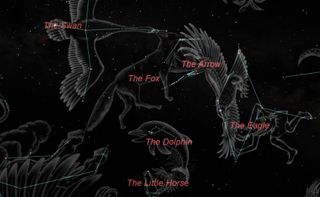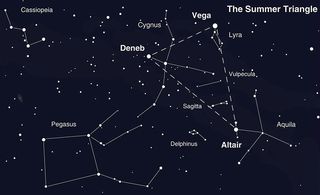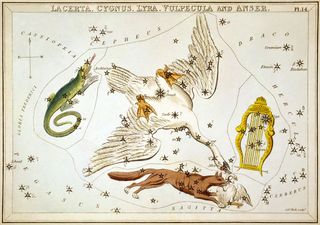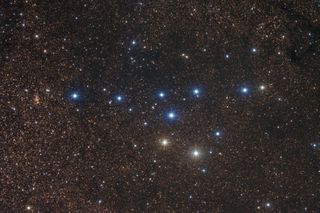
In this week's evening sky, four small, faint constellations spread out near and within the Summer Triangle can be seen.
First, about halfway between the stars Altair and Albireo, are the four stars marking Sagitta, the arrow. To the east are four stars forming a diamond with a fifth to the south. This is Delphinus, the dolphin, sometimes called "Job's Coffin." About as far to the east of Delphinus as the arrow is west, is a very faint trapezoid marking Equuleus, the little horse, or foal. Yet a fourth constellation lying between the first three and Cygnus is Vulpecula, the little fox.
Here we'll give detailed descriptions for each of the star patterns you can find in this patch of the night sky.
Related: Sagittarius Carries a 'Milk Dipper' and 'Teapot' into the Summer Sky
The "charming" dolphin
One of the smallest constellations is reaching its highest point in the sky about 90 minutes after sunset, Delphinus, the dolphin. Dolphins are known today as being the smallest whales. Their family name, in fact, is Delphinidae. That's probably how our "dolphin in the sky" got its name.
Our celestial dolphin is a star pattern that is composed only of faint stars, yet the stars are so close to each other that they can easily be seen on clear, dark nights. It certainly attracted the attention of ancient skywatchers. Here you will find a small diamond with perhaps one or two stars below it, which gives this group a prominence greater than you might otherwise expect from so faint a constellation. In his classic star guide, "The Stars: A New Way to See Them," author H. A. Rey noted, "There is something especially charming about it, positioned out in the dark just east of the bright summer Milky Way." Some reference books refer to the diamond as "Job's Coffin," though the origin of this name is unknown.

According to legend, Arion, a Greek musician, was sailing on board a ship to Corinth, carrying a substantial cache of money and jewels. Unfortunately, the ship's crew planned to throw Arion overboard and abscond with his treasure. When confronted by the pirates, Arion requested that he be allowed to play his harp one final time. The music attracted Delphinus. Upon seeing the dolphin, Arion jumped overboard and was carried safely to shore. When the ship docked at Corinth, the crewmen were arrested and hanged. Arion recovered his treasure and the dolphin was given a place of honor in the sky.
There are some companies that will name a star after you or a loved one — for a nominal fee. But such names are not officially recognized by any reputable astronomical institutions, such as the International Astronomical Union (IAU), which has the official authority to name celestial objects. However, one person apparently got around this using two stars in Delphinus. In star atlases and catalogs, we find these two odd names: Sualocin and Rotanev. They first appeared in the Palermo Star Catalog in 1814. But where did they come from? The English astronomer Thomas Webb finally solved the mystery by reversing their letters, revealing the name of Nicolaus Venator, a Latinized form of Niccolo Cacciatore, the assistant and eventual successor of Palermo Observatory's director, Giuseppe Piazzi. But was it Piazzi or Cacciatore who was responsible for these inverted monikers? Nobody knows.
Get the Space.com Newsletter
Breaking space news, the latest updates on rocket launches, skywatching events and more!
Hercules' arrow?

Between Aquila, the eagle and Cygnus, the swan is a longish figure of four stars, which can pass for an arrow. Sagitta, the arrow is one of the original 48 ancient constellations, with the four stars assigned to it by the Greek astronomer Eratosthenes. The mythology of the arrow is confusing, but once its shape becomes familiar — and it really is true to its name — you should have no trouble sighting it. Although it's a small star pattern, it's quite striking for its size and is located halfway between the heads of the eagle and swan, within the Milky Way.
One legend suggests that the arrow was supposedly shot by Hercules at the Stymphalian Birds as one of his 12 labors. In the sky, the only birds within close range of Hercules were Aquila, the eagle and Cygnus, the swan. If he was trying to bring one or both down, it appears that he missed them both! Note also the similarity in the names of the constellations Sagitta ("arrow") and Sagittarius ("archer").
The little fox (or cowboy boot?)

The little fox owes its position in the sky to that indefatigable user of "unformed" stars — stars that did not belong to any specific star pattern — Polish astronomer Johannes Helevius. In the mid-1600s, he invented the "little fox," sometimes shown with a goose (Anser). Today, the legacy of the goose belongs to but a single star: the brightest of this constellation, Alpha Vulpeculae (magnitude +4.4), whose proper name is Anser.
On most star charts Vulpecula, the little fox seems to be nothing more than a shapeless group of dim stars. But Hugh Rice, who worked at New York's Hayden Planetarium in the 1940s, showed part of this group on his star maps as something resembling a cowboy boot. The boot even boasted a spur — a small spike that is worn on a rider's heel and is used for urging a horse forward. Involving mostly faint stars, Rice's pattern doesn't include Anser. The average visual magnitude of the 12 stars that compose the boot is 5.0, so when all the stars in this celestial shoe are visible with the unaided eye, the sky is transparent and your observing conditions are excellent. Sighted in wide-field binoculars or a telescope's viewfinder, Rice's pattern helps to locate the beautiful Dumbbell Nebula (M27). Picked up with very low power as two hazy patches of light, it assumes a dumbbell appearance in larger telescopes.

While we're investigating Vulpecula, turn your binoculars to the region of the sky about one-third of the way from the bright star Altair to Vega and you will discover Brocchi's Cluster. During the 1920s, Dalmiro Francis Brocchi, chartmaker for the American Association of Variable Star Observers, designed a map depicting the region of the sky around Vulpecula, revealing this star cluster.

In a clear, dark sky you might perceive it with the naked eye as a fuzzy patch of light, but in binoculars you'll see it as a curious grouping of stars. An east-west line of six stars forms a crossbar, and four more form a hook attached to its middle, which combined looks very much like an inverted coat hanger. These 10 stars are all 5th to 7th magnitude. In the Swedish astronomer's Per Collinder's star catalog, drawn up in 1931, it is cluster No. 399, hence its "official" designation is Collinder 399.
The "other" celestial stallion

With the sole exception of the famous Southern Cross (Crux) constellation, Equuleus occupies a smaller space on the sky than any other constellation. It lies just to the southeast of Delphinus, and because it has no bright stars, it is of little interest to stargazers. Its brightest star (magnitude +3.9) is named Kitalpha — Arabic for "little horse." The famous Greek astronomer Hipparchus is believed to have made up this constellation in the second century BC. It has been said to represent Celeris, the brother of Pegasus (the winged horse), given to Castor (one of the Gemini twins) by the Roman god Mercury.
- Sagittarius Carries a 'Milk Dipper' and 'Teapot' into the Summer Sky
- How the Night Sky Constellations Got Their Names
- Astronaut Doodles Constellations on Space Station Photos
Joe Rao serves as an instructor and guest lecturer at New York's Hayden Planetarium. He writes about astronomy for Natural History magazine, the Farmers' Almanac and other publications, and he is also an on-camera meteorologist for Verizon FiOS1 News in New York's lower Hudson Valley. Follow us on Twitter @Spacedotcom and on Facebook.
Join our Space Forums to keep talking space on the latest missions, night sky and more! And if you have a news tip, correction or comment, let us know at: community@space.com.

Joe Rao is Space.com's skywatching columnist, as well as a veteran meteorologist and eclipse chaser who also serves as an instructor and guest lecturer at New York's Hayden Planetarium. He writes about astronomy for Natural History magazine, the Farmers' Almanac and other publications. Joe is an 8-time Emmy-nominated meteorologist who served the Putnam Valley region of New York for over 21 years. You can find him on Twitter and YouTube tracking lunar and solar eclipses, meteor showers and more. To find out Joe's latest project, visit him on Twitter.
